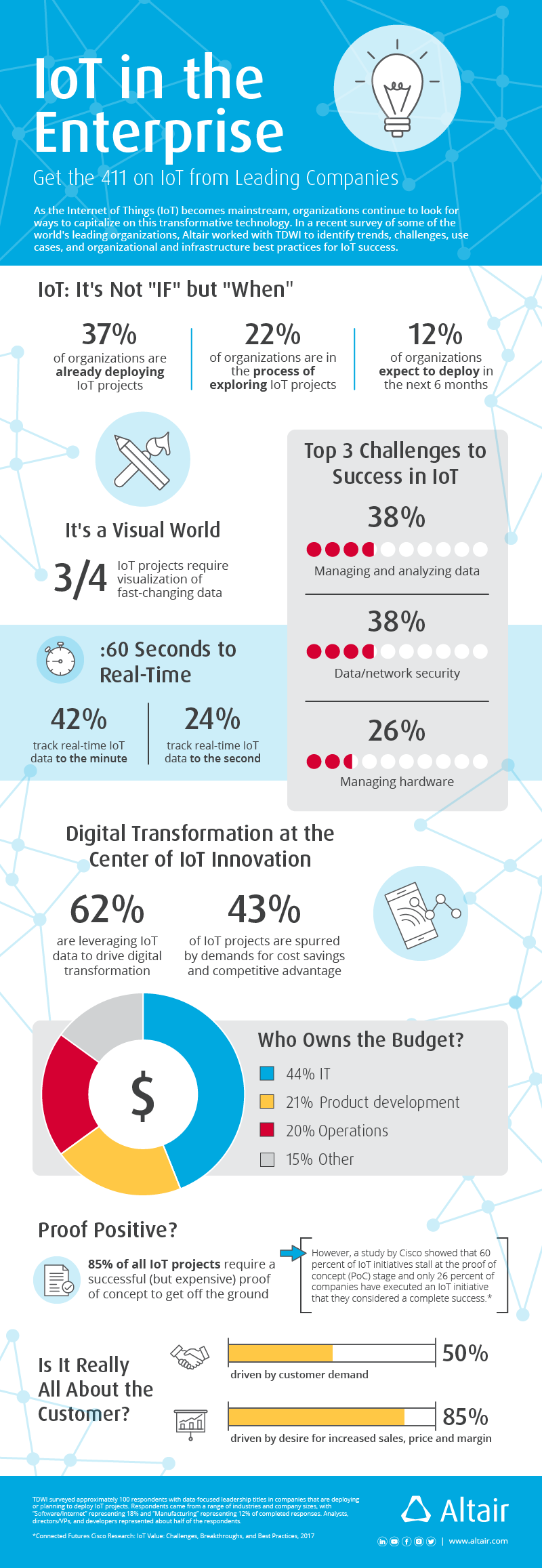IoT Business Trends: Insights from TDWI
The Internet of Things (IoT) has become an important part of today’s business ecosystem with digital transformation being the main reason for its adoption. Companies are taking advantage of their data and using connected technologies to put that precious resource to work. But how effectively are they using it?
To answer this, we recently worked with data intelligence leader TDWI, to survey more than 100 companies about how they use IoT technology and what challenges they face. Participants included analysts, directors, VPs, developers and more. There was a wide range of company sizes in industries including software and manufacturing.
What TDWI found was that 41 percent of businesses surveyed are already deploying IoT, 12 percent expect to do so in the next six months and another 25 percent are exploring the technology. The range of use cases that respondents cited highlight the ubiquity of IoT as a technology of choice to compete effectively as well as grow new streams of revenue. Respondents cited several IoT use cases including automotive applications, disaster response, and system security.
IoT Challenges
Security is the highest priority among businesses implementing IoT technology, followed by managing real-time and dealing with hardware. Altair SmartWorks™ takes these important aspects seriously in order to ensure the security, reliability, and integrity of communications between external applications and the IoT platform.
These complex variables aren’t always easy to manage. On the business side, it can also be a colossal challenge to identify the right use case, budget, and get user and management buy-in.
When TDWI survey respondents were asked for the top reason IoT projects fail, lack of a business use case topped the list at 31 percent. That significant number illustrates the crucial importance of evaluation, planning, strategy development, and the need for an executive champion for IoT.
IoT initiatives are still largely driven by IT teams, with an increasing participation from operations and product development groups. This indicates that IoT is more than a technology decision and plays a role in the overall business success.
Predictive Analytics & Data Visualization
80 percent of TDWI survey participants said it’s critical to visualize real-time IoT data, as it’s being generated. Powerful visualization tools are mandatory to drive action and insight when considering predictive maintenance, a task performed by a combination of operators and analytic tools. When respondents were asked how often they need to visualize fast-changing data, 41 percent said once a minute. Add a multitude of data sources to work with that are both real-time and historical, and the application of machine learning, then the real value of IoT data starts to appear.
Many IoT vendors only capture time signals from assets and display them in dashboards. Closing the loop, predicting behavior and taking the right action is where predictive analytics becomes an enablement technology. For example, Altair Data Analytics lets businesses monitor, process and visualize their data, which ultimately allows them to predict the action that follows and in many cases also guides product development teams to better define the next version of a product.
The Importance of IoT Strategy
Although more companies than ever before have started collecting IoT sensor-generated data, many still don’t have an IoT strategy that aligns with the larger business objectives. Even in the context of applying data science to the IoT generated data, companies have been slow to establish global strategies for managing their IoT projects. Instead, with few exceptions, projects are led by early adopters – engineers, analysts, or data scientists – who push for these projects in their own departments. As a result, overall adoption can be a long, slow process.
IoT today is where data science was 20 years ago. Broad adoption comes with growing pains and as IoT reaches maturity, organizations are finding that they need to adapt the way they do business.
Connected Products Lead IoT Adoption
Connected products are an example where the customer demand will drive the future growth of IoT technology, while also benefitting the product development and manufacturing organizations through increased margins. Such connected products will demand more than connectivity to the internet and will need to account for the fundamental design and engineering changes that the products will undergo. This warrants a much wider perspective including product design, engineering R&D, systems design, production, business unit, and analytics teams. It will require more than an individual or departmental focus. Broader adoption will necessitate a clearly identified strategy that is integral to organizational goals and in most cases requires a direction from the top management.
Platforms like Altair SmartWorks work seamlessly with other design and engineering tools, and analytical platforms that allow users to build highly scalable, smart products and related IoT applications. This sets them on a path to implement successful digital twin strategies. Combined with SmartWorks, Altair HyperWorks™, and Altair Knowledge Works offer a smart product development environment under a unique licensing system for organizations to use in their smart product development journey.
Gaining an IoT Advantage
Most of today’s businesses are either already using IoT or planning for a future that includes it. In the TDWI survey, reasons for developing connected products included increased revenue and gaining first-mover advantage. However, the effective use of IoT data it is still in its infancy. There remains significant opportunities to further boost revenue, operate more efficiently, improve product performance, and be positioned as a truly forward-thinking organization.
Altair works with organizations of all sizes and in a broad variety of industries to effectively implement IoT technology, helping businesses run more efficiently with the power of data.
Contact us today to discuss your IoT opportunities.
For a full view of results from TDWI, click here.





